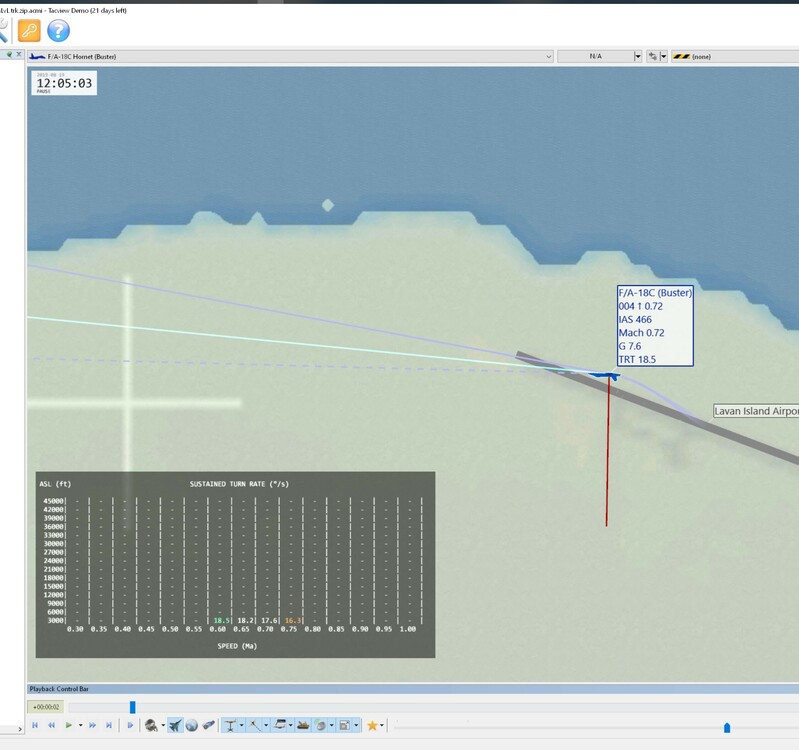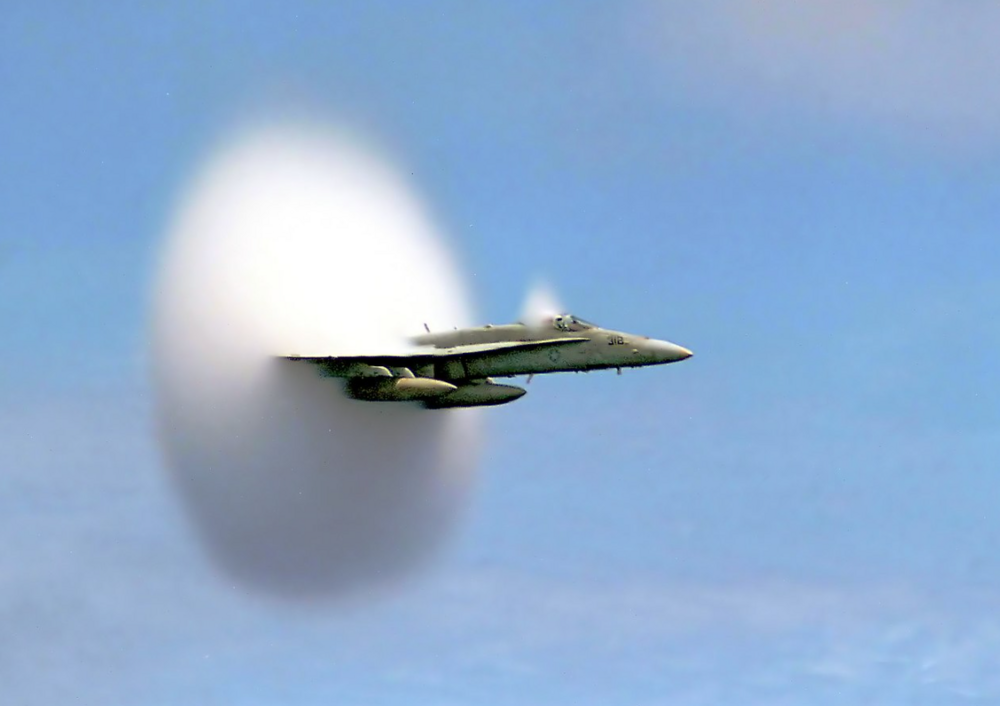-
Posts
1842 -
Joined
-
Last visited
-
Days Won
1
Recent Profile Visitors
16010 profile views
-
Here's a nice little break turn video of a small-motored Canadian CF-18 in 1988 doing 360 degrees in about 16 seconds... averaging a nice little 22 degrees per second, and with energy to spare.
-
Yeah, the team really does have DCS firing on all cylinders... it really is a joy to pick it back up after some time away as you kind of forget/take for granted how incredible a sim it is that they've achieved. Welcome back.
-
Indeed. Here's a nice little break turn video of a small-motored Canadian CF-18 in 1988 doing 360 degrees in about 16 seconds... averaging a nice little 22 degrees per second, and with energy to spare.
-
A quick post as a reference: There is a fair bit of misinformation floating about regarding the DCS Hornet and it's Sustained Turn Rate (over) performance in the form of user created EM diagrams, Youtube videos, etc. I submit that ED has pretty much nailed it. Here is a completely slick Hornet with 60% internal gas, at near-sea level, through a few max G turns...But keep in mind, I've flown these WITHOUT the paddle switch employed, as a real USN Hornet would be (and which would be reflected in real world EM performance charts) flown, real world. This is obviously only one, non-extensive, test, but you get the picture. The paddle makes a fairly significant difference. Max sustained turn rate in this test was 18.5 Deg per sec. These were all max stick deflection pulls, in full AB. You can definitely get the little chart at bottom left to read higher in the 23-24 deg per sec range, but if you actually watch the live "object box", those dps are not sustained but momentary, and at low airspeeds... which makes the chart itself a bit misleading. Truly sustained, after testing both the Viper and the Hornet, the Viper has a consistent 1.5-2 deg per sec. sustained advantage when watching the live object box in TacView. STR - Slick Hornet - SeaLvL.trk Tacview-20240402-215526-DCS-STR - Slick Hornet - SeaLvL.zip.acmi
-
But did you fly through the path that he'd been on before he was far from you? As you know, those wakes linger for a fair bit. As said, a track will be best for diagnosis.
-

F/A18E/F Super Hornets block 1 and BLock 2 E/F ( lot 26)
wilbur81 replied to Kev2go's topic in DCS Core Wish List
This ^^^ As the pilots say, "There's nothing "Super" about the Super Hornet. -
The slow-mo is actually kind of unhelpful in diagnosing the problem... but my guess would be you flew through the bandit's lingering wing-vortices? Happens to me all the time in BFM when in the same maneuvering plane/circle as the bandit.
-
Agreed. I've had a good bit of time to play with the new FM. They've done an amazing job overall (no surprises there )... but we still do not seem to get the kind of pitch authority/nose rate at those speeds that you see demonstrated by real world Legacy Hornets in (absolutely incredible) videos such as these. We are getting close...
-

correct as-is Current FM Thrust-Drag w/ 3 bags vs Real World
wilbur81 replied to wilbur81's topic in Bugs and Problems
Gosh, I'm an idiot. I was doing some MIL power top speed testing too and must have just crossed my i's and dotted my x's that day. -

reported Wings rip off with passing through wake turbulence
wilbur81 replied to Shik's topic in Bugs and Problems
Haven't looked at your tracks...but just a couple thoughts: - Try creating a fresh mission from scratch. There seem to be some weird things going on with stock/older missions. - Are you pulling the paddle switch in your turns and over-g'ing? If so, don't. -

correct as-is Current FM Thrust-Drag w/ 3 bags vs Real World
wilbur81 replied to wilbur81's topic in Bugs and Problems
Indeed...I had the controls indicator on as well just to confirm... I think it must have been a faulty mission as mentioned about. A freshly created mission and things looked good. -

correct as-is Current FM Thrust-Drag w/ 3 bags vs Real World
wilbur81 replied to wilbur81's topic in Bugs and Problems
Whoa... how did you manage M0.99 at 500ft!? Did you watch my track? I was at 700ft in my test and couldn't break M 0.90 until the final few miles when I got to Mach 0.91... and I didn't even have wingtip Sidewinders and started with 20% internal fuel at 14 deg Cel. air temp. Are you on 9.2.3 and do you have a track of your flight? **EDIT** Well, I'll be darned!! I went back and tried my test again, Raven. But this time, I created a new mission from scratch (I believe my first test was the stock Persian Gulf Carrier Launch Supercarrier mission or some similar, older stock mission). Same config, same altitudes, air temps, and fuel loads...and got almost exactly what Wombat describes. BIGNEWY, unless we still want to do some testing with the extra pylons and the Mach passes as displayed in my two real world pics above (which I have not yet) to see how she does in-game, I guess you can go ahead and delete this thread...but I'm wondering if there is some mission corruption with the new update and stock missions? -

correct as-is Current FM Thrust-Drag w/ 3 bags vs Real World
wilbur81 replied to wilbur81's topic in Bugs and Problems
There may be a slight reduction on that side of the envelope too... but I have no knowledge of what a real EPE Legacy Hornet could do at that altitude, especially with that particular (very draggy) configuration (and I'm VERY confident there's nothing available that isn't classified). To stay on topic though, I've started this thread because there is available reason to believe that our DCS Hornet should quite possibly be able to get to (possibly exceed?) M1.0 with three bags and otherwise slick down low...which it currently cannot in-game. But again, all I have to contribute is some photos and the anecdotes of Wombat. -

correct as-is Current FM Thrust-Drag w/ 3 bags vs Real World
wilbur81 replied to wilbur81's topic in Bugs and Problems
I totally see what you're getting at... but that is not the nature of the question or the bug report... It is this: The real Legacy Hornet can apparently (but that's why we're here in this thread) safely hit very close (per the photos) or even break (per pilot's anecdote above) Mach 1 down low with three bags... Our simulated Legacy Hornet in DCS currently cannot. -

correct as-is Current FM Thrust-Drag w/ 3 bags vs Real World
wilbur81 replied to wilbur81's topic in Bugs and Problems
Thanks for looking into it, BIGNEWY. I have no data, just this anecdote... I figured Wags and Wombat could sort it out for us when they get a chance. Cheers! PS - This isn't necessarily 'data,' and I know that these condensation vapes can be produced slightly before going through the Mach... but thought I'd throw this in anyway. Some thoughts: Note the empty pylons in addition to the three tanks. This photo is most likely taken from the boat for a low alt. 'morale pass' as you rarely get those vapes at altitude. Currently, our Hornet will get no where near 0.97m-1.00m down low with three tanks (and that's without the extra pylons). Here's the caption and link: https://en.wikipedia.org/wiki/Supersonic_speed#/media/File:FA-18_Hornet_breaking_sound_barrier_(7_July_1999)_-_filtered.jpg Off the coast of Pusan, South Korea: An F/A-18 Hornet assigned to Strike Fighter Squadron One Five One (VFA-151) breaks the sound barrier in the skies over the Pacific Ocean. VFA-151 is deployed aboard USS Constellation (CVN 64). This is an edited version (reduced grain). ...and here is another similar photo example with link and caption for reference: https://commons.wikimedia.org/wiki/File:Supersonic_aircraft_breaking_sound_barrier.jpg The Commanding Officer of the "Black Knights" of Marine Fighter Attack Squadron Three One Four (VMFA-314) performs a supersonic fly-by for Columbia's visual effects unit, while filming for the motion picture production "Stealth" on board USS Carl Vinson (CVN 70). The Bremerton, Wash.-based nuclear powered aircraft carrier is currently underway for the first time since returning from an eight and half month western pacific deployment. Carl Vinson is conducting training with Carrier Air Wing Nine (CVW-9) and units of the Carl Vinson Carrier Strike Group.








